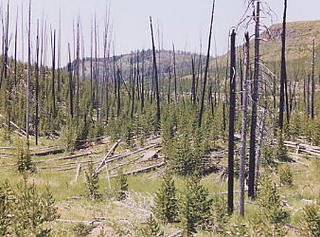
July 15, 2005
When I decided to come through the south entrance to Yellowstone, I was not aware that I would pass through Grand Teton National Park first. The Tetons and surrounding park lands are just magnificent -- lush and green.
Yellowstone, while unique and beautiful, did not inspire or move me as much as the Tetons. In my limited time, I was able to visit Lewis Canyon and Falls, the West Thumb Geyser Basin, Yellowstone Lake, Old Faithful, Midway Geyser Basin and Firehole River, Firehole Canyon and Falls, and the Gibbon River.
I also stopped to see Artists Paintpots, but the hike was a little too far, so I turned back. I am sorry now that I didn't go the whole way because this area is noted for having several examples of thermal features such as small geysers, mudpots, and steam vents. This spot is the best place to see excellent close-up views of mudpots.
I did not find Old Faithful to be that spectacular. I sat in the sun for 70 minutes waiting for the next eruption, having missed the prior eruption by about 20 minutes. The interval between eruptions is about 92 minutes, and the duration is anywhere from 1 1/2 to 5 minutes.
I especially enjoyed the West Thumb Geyser Basin. This is the largest geyser basin on the shores of Yellowstone Lake. The magma chamber that heats Yellowstone's thermal features is close to the surface here -- less than 2 miles under the earth's surface. The same thermal features are also found in Yellowstone Lake and can be seen from the shore. It is amazing how intense the heat is when standing near the springs and vents.
Midway Geyser Basin contains two very beautiful and colorful prismatic springs -- the Excelsior and the Grand Prismatic Spring. The water from these hot springs empty into the Firehole River in a cloud of steam.
One of the most remarkable things I noticed was the enormous amount of burn acreage. At one of the check points, an information board explained that even though forest fires are devastating, they actually play an important role in returning nutrients to the soil. Some plant communities depend on fire to remove overgrowth and encourage new growth. It was easy to tell which burn areas were recent and which were not. Over 1.4 million acres burned in 1988.
Because I am traveling alone, I tend to reflect. As I observed mile after mile of visible reminders of burn, it made me think about endings and new beginnings -- not only in nature, but in our lives as well.
I am now at Yellowstone Basin Inn about 5 miles north of Gardiner, Montana. The geology of the area is much different than in Driggs and Jackson Hole. The territory there was green; here it is brown.
Tomorrow I hoped to back track to Canyon Village to see the Lower Falls in the Grand Canyon of the Yellowstone River, but I don't think I will have enough time before I head northwest to Missoula.
Having just reread this entry, I think I sound like a teacher!
Oh well --










1 comment:
Deb, I had to reread... sound like a teacher? Actually you sound a little frustrated, a hint of disappointment amongst the sharing of your wonderful trip and thoguhts. I have often visited Rotorua and Taup thermal areas in New Zealand. Such power! Or is it like a crop of acne? lol.
There is always something round the next corner that is so near but just so far. But this is your trip and your experience, what was round the corner is just not lucky enough to be incorporated into your memories.
Jan, who should return to work on Monday but wont be!
Post a Comment